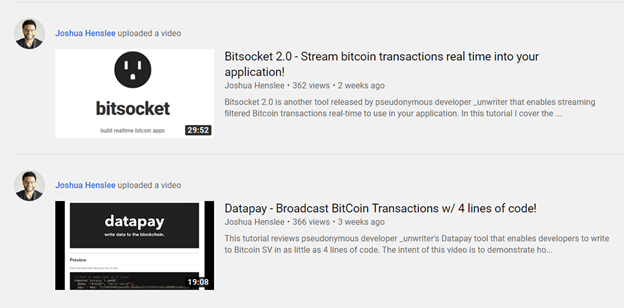|
Getting your Trinity Audio player ready...
|
Recently, I have started a YouTube channel where I intend to release coding tutorials demonstrating how easy it is to start building on top of Bitcoin SV.

My first tutorial was about an unwriter tool named Datapay that allows us to broadcast Bitcoin SV transaction with as little as 4 lines of JavaScript code. JavaScript is code that runs on Internet browsers and given that we need internet connectivity to interact with Bitcoin SV, it is the natural choice of programming language to conduct the tutorials in. I have found that most of the application development tools released to date have been implemented in JavaScript.
My first tutorial was motivated by a claim I made back in May at CoinGeek Toronto while presenting on unwriter’s tools that Datapay was the best tool to begin with.
"If you want to get into building Bitcoin apps, start with Datapay, a simple application."
– @cryptoAcorns #CoinGeekToronto pic.twitter.com/Yr8RhJeSts
— Kevin Pham (@_Kevin_Pham) May 29, 2019
JavaScript is a very easy language to start with and appropriate for beginners. Additionally, being able to send Bitcoin SV to someone and write data to the ledger at the same time so easily greatly lowers the barrier to entry to application development. My intent in this first tutorial was demonstrate how easy it is to start, in hopes to motivate newbies to keep going.
My second tutorial was about Bitsocket 2.0, yet another unwriter tool that provides an endpoint to listen for certain transaction types. I built on top of the first tutorial by sending transactions in the same manner and showing how to catch and receive them with Bitsocket. I felt like this was a natural second tutorial since this tool allows for reading from the ledger, and Datapay writes to it.
In the first tutorial I only developed in the browser and HTML, but in the second I began to demonstrate Node.js—which is simply server-side JavaScript. I do review some basic functions of it so that beginners learn how to use it. Node is very useful for Bitcoin SV development because we can have programs running server side that interact with the ledger, not just trigger transactions from client-side interaction in the browser. Additionally, we may want to store some data on the server, so node is more convenient for that purpose.
My third tutorial was on Proxypay, how we can process more complex transaction types without pigeon-holing our application into only accepting one type of payment. One valid criticism of some applications is that they require and only accept transactions paid via MoneyButton which I wrote about here.
I try to build on my first two tutorials and demonstrate how to use Proxypay in HTML on the client side and Node.js on the server side. I also feel that using this tool can improve an understanding on how Bitcoin works as it implements BIP 21 and private key management.
My fourth tutorial was released in celebration of the Return to Genesis that restored standard Bitcoin functionality that was present in version 0.1. This tutorial reviewed how to create nLockTime transactions, which are valid after only a certain point in time or block height. The video also reviews how to construct standard multi-signature transactions without the controversial Pay-to-script-hash functionality.
In these videos I cannot help but interject some of my opinions on how this functionality can be used and some of its history. This is notable in my video about multi-signature transactions, because the ecosystem will have to implement this functionality 11 years after it was available due to how it was handicapped. I hope this commentary can add some color to the nature of these tools and help the viewers understand the why behind them, not just the how.
Conclusion
My goal with this YouTube channel is to enable others to build by demonstrating how easy it is. Bitcoin SV needs transaction volume yesterday. The halving approaches and we must find ways to replace lost miner revenue with fees.
The most straight-forward way to achieve this is entrepreneurs coming in, taking advantage of the lower barrier to entry that Bitcoin SV offers and building businesses that people want to use.
I posted this tweet in December 2019:
I personally know 3 different people who could not code at all 1 year ago but are now building applications on top of $BSV.
— shua (@cryptoAcorns) December 18, 2019
I hope this motivates potential builders to start today.
Please let me know of any feedback on my channel and what content you would like to see going forward. Also if you have an interest, like, subscribe and share!

 12-20-2025
12-20-2025 




